Conceptual Knowledge
5.0(4)
5.0(4)
Card Sorting
1/113
Earn XP
Description and Tags
Chapter 9 Notes
Study Analytics
Name | Mastery | Learn | Test | Matching | Spaced |
|---|
No study sessions yet.
114 Terms
1
New cards
What is semantic dementia?
causes a general loss of knowledge for all concepts
2
New cards
What is the hub and spoke model?
areas of the brain that are associated with specific functions are connected to the ATL, which serves as a hub that integrates the information from these areas
3
New cards
What are the six types of ATL functions?
include valence—which is weak versus strong (yellow); speech (pink); auditory (red); praxis—which refers to involving manipulation (dark blue); functionality (light blue); and visual (green)
4
New cards
What is TMS?
studying the brain via applying a pulsating magnetic field using a stimulating coil placed over the person’s skull
5
New cards
What is an error signal?
erroneous responses in property unit sent back as a signal
6
New cards
What is back propagation?
when error signals are being sent backward in the network starting from the property units
7
New cards
What is hierarchical organization?
kind of organization in which larger, more general categories are divided into smaller, more specific categories, creating a number of levels of categories
8
New cards
What is the subordinate level/global?
a category
9
New cards
What is the basic level?
a basic example of the category
10
New cards
What is the specific level?
a specific example of the category
11
New cards
What is a category?
all possible examples of a particular concept
12
New cards
What is categorization?
the process by which things are placed in categories
13
New cards
What is category specific memory impairment?
an impairment in which they had lost the ability to identify one type of object but retained the ability to identify other types of objects
14
New cards
What is the sensory functional approach?
states that our ability to differentiate living things and artifacts depends on a memory system that distinguishes sensory attributes and a system that distinguishes functions
15
New cards
What is the multiple-factor approach?
idea of distributed representation is a central feature to searching for factors beyond sensory and functional that determine how concepts are divided within a category
16
New cards
What is cognitive economy?
way of storing shared properties just once at a higher-level node
17
New cards
What is a concept?
the mental representation of a class or individual and categories of objects, events, and abstract ideas
18
New cards
What is conceptual knowledge?
knowledge that enables us to recognize objects and events and to make inferences about their properties
19
New cards
What is connectionism?
an approach to creating computer models for representing cognitive processes
20
New cards
What is parallel distributed processing (PDP)?
propose that concepts are represented by activity that is distributed across a network
21
New cards
What is a connectionist network?
a network shows how the neurons are arranged and connected, how information flows from one neuron to another, & how connection weights change over time
22
New cards
What is a unit?
a neuron
23
New cards
What is an input unit?
Units activated by stimuli from the environment (or stimuli presented by the experimenter)
24
New cards
What is a hidden unit?
components comprising the layers of processors between input and output units in a connectionist system
25
New cards
What is an output unit?
produce results for given inputs
26
New cards
What is a connection weight?
determines how signals sent from one unit either increase or decrease the activity of the next unit
27
New cards
What is crowding?
refers to the fact that animals tend to share many properties
28
New cards
What is the definitional approach to categorization?
decide whether some-thing is a member of a category by determining whether a particular object meets the definition of the category
29
New cards
What is embodied approach?
states that our knowledge of concepts is based on reactivation of sensory and motor processes that occur when we interact with the object
30
New cards
What is semantic somatotopy?
correspondence between words related to specific parts of the body and the location of brain activity
31
New cards
What is exemplar approach to categorization?
involves many examples determining whether an object to similar to other objects
32
New cards
What are exemplars?
are actual members of the category that a person has encountered in the past
33
New cards
What is family resemblance?
idea that things in a particular category resemble one another in a number of ways
34
New cards
What is graceful degradation?
idea that things in a particular category resemble one another in a number of ways
35
New cards
What is lexical word task?
participants read stimuli, some of which are words and some of which are not words -→ their task is to indicate as quickly as possible whether each entry is a word or a nonword
36
New cards
What is priming?
occurs when presentation of one stimulus facilitates the response to another stimulus that usually follows closely in time
37
New cards
What is typicality effect?
ability to judge highly prototypical objects more rapidly
38
New cards
What is a prototype?
“typical” member of the category
39
New cards
What is prototype approach to categorization?
membership in a category is determined by comparing the object to a prototype that represents the category
40
New cards
What is typicality?
a phenomenon whereby typical items are more easily judged as members
41
New cards
What is the semantic network approach?
proposes that concepts are arranged in networks.
42
New cards
What is the hierarchical model?
because it consists of levels arranged so that more specific concepts, such as “canary” and “salmon,” are at the bottom and more general concepts are at higher levels
43
New cards
What is sentence verification technique?
determine how rapidly people could answer questions about an object’s category
44
New cards
What does categories help us understand?
individual cases not previously encountered
45
New cards
How does categories point us to knowledge?
1). Provide a wealth of general \n information about an item \n
2). Allow us to identify the special \n characteristics of a particular item
2). Allow us to identify the special \n characteristics of a particular item
46
New cards
Why is it important to know a category?
Knowing that something is in a category provides a great deal of information about it
47
New cards
What are the characteristics of the definitional approach to categorization?
• Does not work well \n • Not all members of everyday categories have the same defining \n features \n • Family resemblance
48
New cards
What are the characteristics of the prototype approach?
\
Characteristic features that describe what members of that concept are like \n
An average of category members encountered in the past
Characteristic features that describe what members of that concept are like \n
An average of category members encountered in the past
49
New cards
Why doesn’t the definitional approach not work well?
for most natural objects (such as birds, trees, and plants) and many human-made objects (like chairs), definitions do not work well at all
50
New cards
What is high prototypicality?
a category member closely resembles the category prototype
51
New cards
If I describe the a robin for the category bird, what is this known as?
“Typical” member for the bird category having high prototypicality
52
New cards
What is low prototypicality?
a category member does not closely resemble the category prototype
53
New cards
If I describe the a penguin for the category bird, what is this known as?
“atypical” member for the bird category having low prototypicality
54
New cards
What has a strong positive relationship?
prototypicality and family resemblance
55
New cards
Why is family resemblance important to the prototype approach?
degree of overlap wrt characteristics of other items in a category
56
New cards
What does it mean to have a large amount of overlap?
high family resemblance (e.g., chair and sofa in furniture category)
57
New cards
What does it mean to have a small amount of overlap?
\
low family resemblance (e.g., mirror and phone in furniture category)
low family resemblance (e.g., mirror and phone in furniture category)
58
New cards
What is the typicality effect?
prototypical objects are processed preferentially
59
New cards
What was the task in Smith and coworkers experiment?
sentence verification task
60
New cards
What were the results of Smith and coworkers experiment?
Highly prototypical objects judged more rapidly ie. an apple/pomegranate is a fruit
61
New cards
What was the task of Rosch’s experiment?
Prototypical objects are named first in a list of objects in that category) -→ Participants first heard the prime, which was the name of a color, such as “green.” Two seconds later they saw a pair of colors side by side and indicated, by pressing a key as quickly as possible, whether the two colors were the same or different
62
New cards
What were the results of Rosch’s experiment?
Prototypical category members are more affected by a priming stimulus = Hearing “green” primes a highly prototypical “green”
63
New cards
What is the reaction time for the sentence verification task?
Reaction time (RT) was faster for objects rated higher in prototypicality
64
New cards
What were the results for condition A of the Rosch’s priming test?
person’s “green” prototype matches the good green
65
New cards
What were the results for condition B of the Rosch’s priming test?
is a poor match for the light green
66
New cards
What were the results for condition C of the Rosch’s priming test?
shows the condition in which colors were different
67
New cards
What was the finding of the Rosch’s priming experiment?
priming resulted in faster “same” judgments for prototypical colors than for nonprototypical colors
68
New cards
What are actually category members?
Examples (exemplars)
69
New cards
What is the similarity to prototype view (exemplar approach)?
Representing a category is not defining it
70
New cards
What is the difference to prototype view (exemplar approach)?
– Representation is not abstract \n – Descriptions of specific examples
71
New cards
How does the exemplar approach show the family resemblance effect?
The more similar a specific exemplar is to a known category member, the faster it will be categorized
72
New cards
What does the exemplar approach explain?
Explains typicality effect – objects that are like more of the examplars are classified faster
73
New cards
What does the exemplar approach easily account for?
\- Easily takes into account atypical cases (e.g., \n flightless birds) \n
\- Easily deals with variable categories
\- Easily deals with variable categories
74
New cards
What does exemplars work best for?
smaller categories
75
New cards
What does prototypes work best for?
larger categories
76
New cards
What does one must consider in order to categorize objects?
properties of objects & learning and experience of perceivers
77
New cards
The basic level is?
“psychologically privileged”
78
New cards
Furniture is on level of the hierarchical organization chart?
global level
79
New cards
Chair, Table, and Bed is on level of the hierarchical organization chart?
basic
80
New cards
Kitchen, dining room, and single/double is on level of the hierarchical organization chart?
specific
81
New cards
What happens when you go above the basic level?
large loss of information
82
New cards
What happens when you go below the basic level?
little gain of information
83
New cards
What were the results of Tanaka’s and Taylor’s experiment?
Experts (left pair of bars) used more specific categories to name birds vs. nonexperts
(right pair of bars) used more basic categories
(right pair of bars) used more basic categories
84
New cards
What was the experiment that Tanaka and Taylor proposed?
They asked bird experts and nonexperts to name pictures of objects -→ There were objects from many different categories (tools, clothing, flowers, etc.), -→ in how the participants responded to the four bird pictures.
85
New cards
What was Collins and Quillian’s model of semantic network?
\
\- Node = category/concept \n - Concepts are linked \n – Model for how concepts and properties are associated \n in the mind
\- Node = category/concept \n - Concepts are linked \n – Model for how concepts and properties are associated \n in the mind
86
New cards
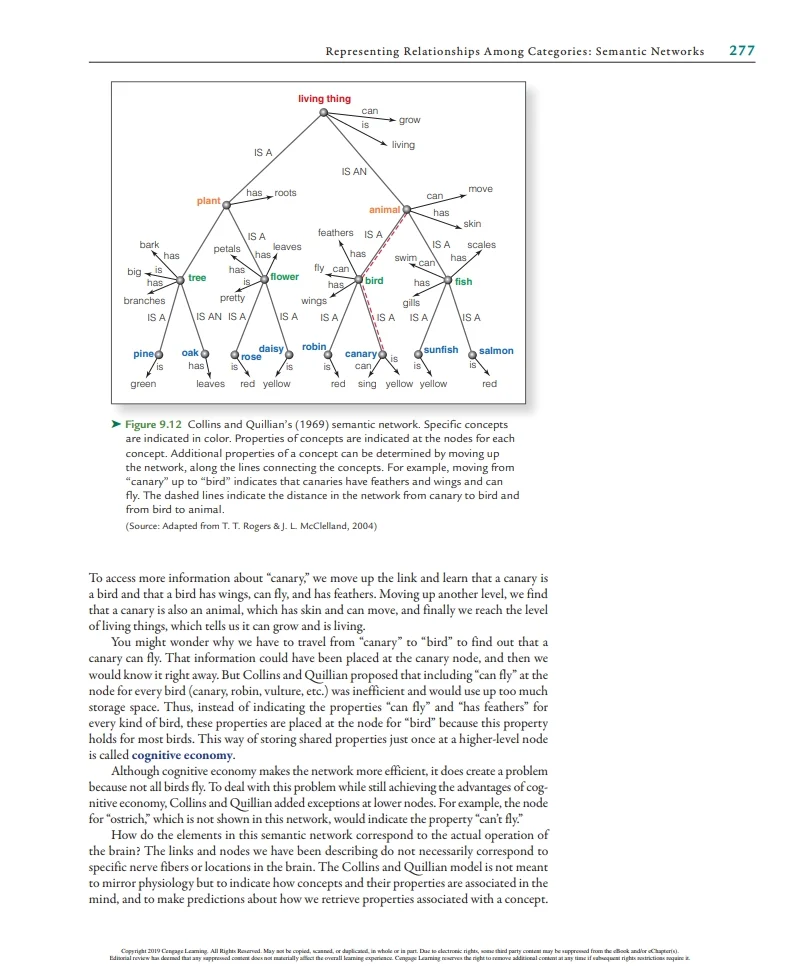
What does this model show?
1). Specific concepts are indicated in color \n 2). Properties of concepts are indicated at the nodes for each concept
3). Additional properties of a concept can be determined by moving up the network, along the lines connecting the concepts
3). Additional properties of a concept can be determined by moving up the network, along the lines connecting the concepts
87
New cards
What is an example of the semantic network?
moving from “canary” up to “bird” indicates that canaries have feathers and wings and can fly -→The dashed lines indicate the distance in the network from canary to bird and from bird to animal
88
New cards
What is apart of a semantic network?
cognitive economy
89
New cards
What is stored at lower nodes?
exceptions
90
New cards
What is Collins and Quillian’s experiment and what did it test?
Tested the prediction that when using the sentence verification technique, in which participants are asked to answer “yes” or “no” to statements about concepts -→ reaction time to a number of different statements
91
New cards
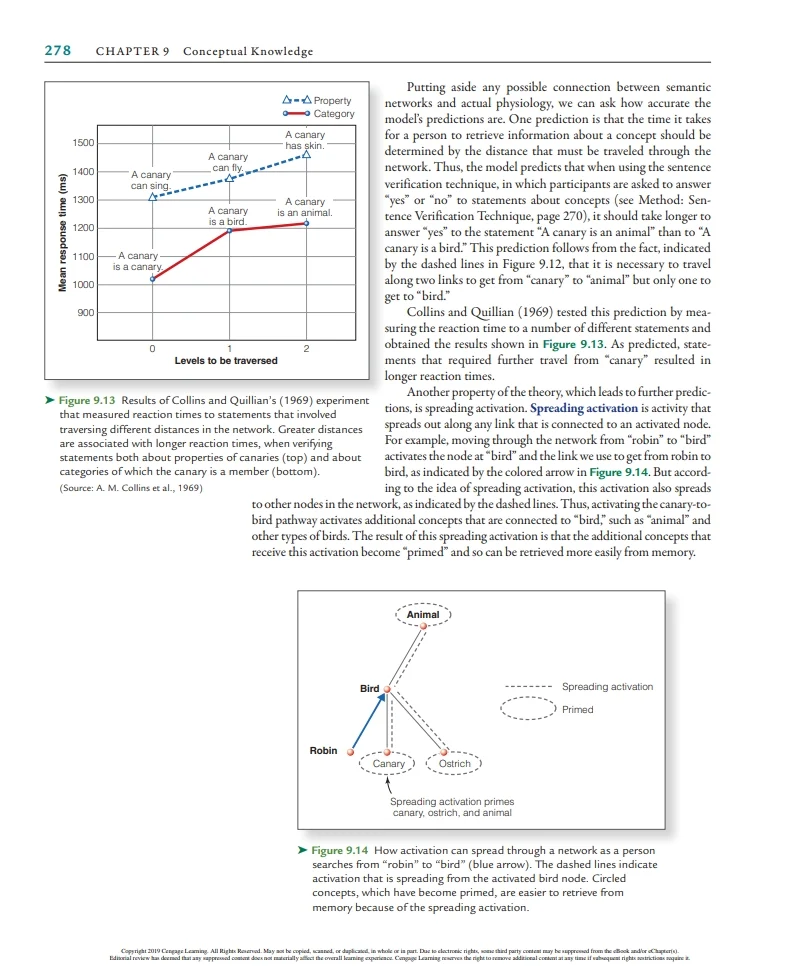
What were the results of Collins and Quillian’s experiment?
Greater distances are associated with longer reaction times, when verifying statements both about properties of canaries (top) and about categories of which the canary is a member (bottom)
92
New cards
What happens during activation in spreading activation?
Activation is the arousal level of a node
93
New cards
What happens when a node is activated?
activity spreads out along all connected links
94
New cards
What happens to concept during spreading activation?
Concepts that receive activation are primed and more easily accessed from memory
95
New cards
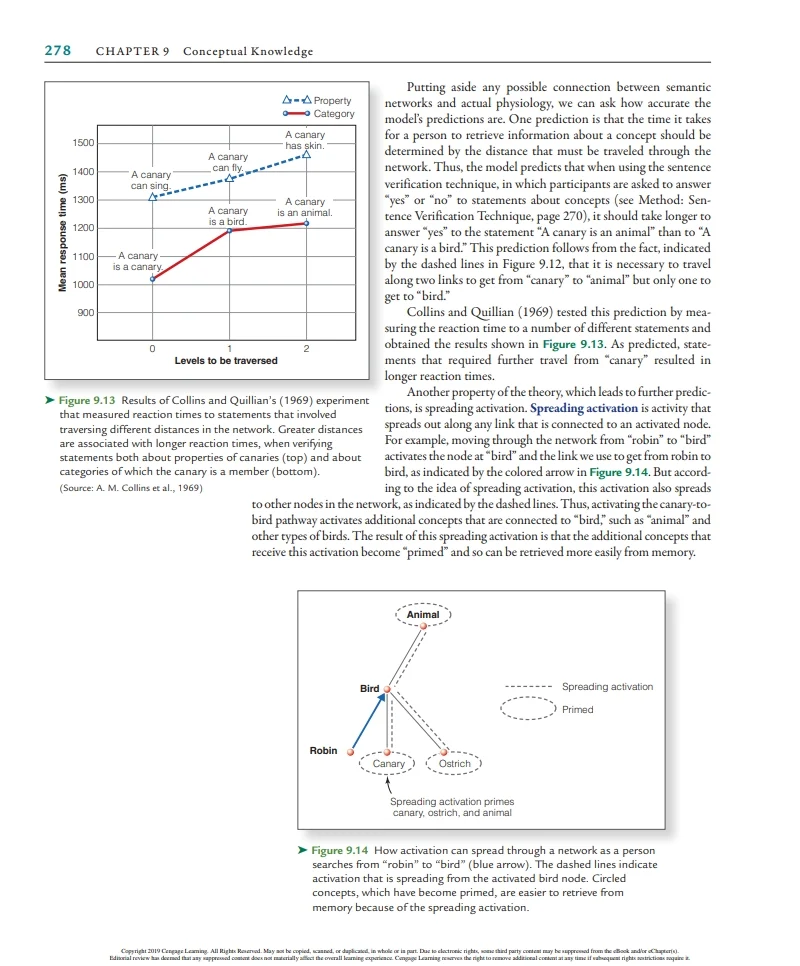
What does figure 9.14 dashed lines represent?
indicate activation that is spreading from the activated bird node
96
New cards
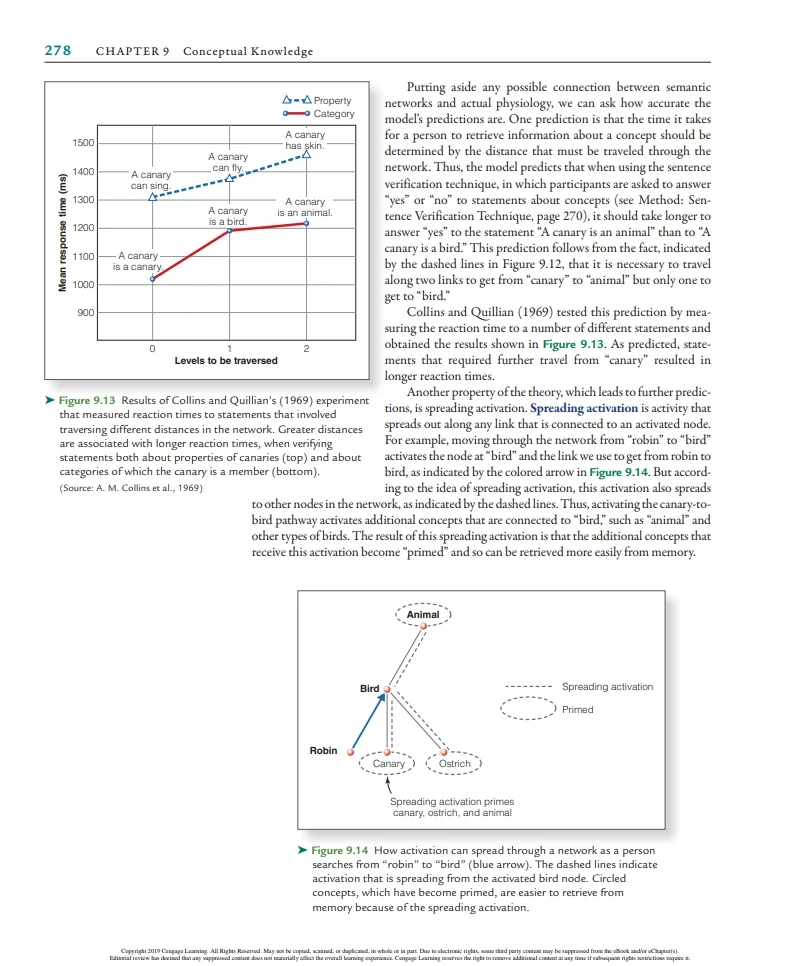
What does figure 9.14 circled concepts represent?
Circled concepts, which have become primed, are easier to retrieve from memory because of the spreading activation
97
New cards
What words were used in the lexical decision task?
desk vs. glurp
98
New cards
What was the task of Meyer experiment?
The participants’ task was to press, as quickly as possible, the “yes” (doctor-nurse) key when both items were words or the “no” (butter-nurse) key when at least one item in the pair was a nonword.
99
New cards
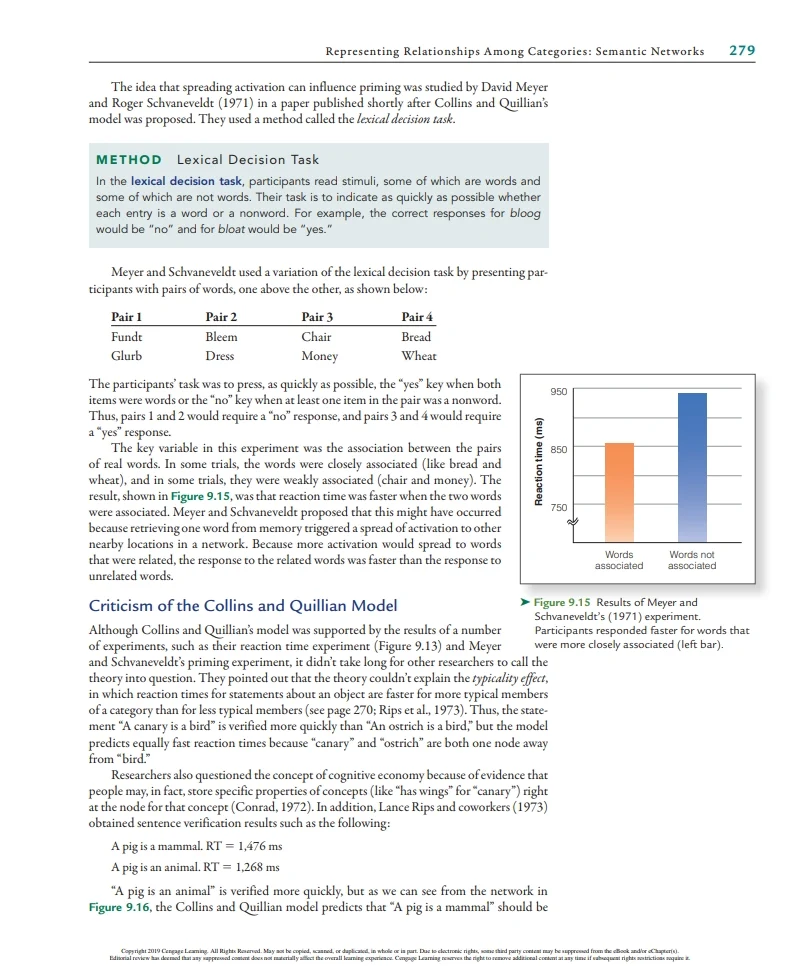
What were the results of Meyer and Schvaneveldt’s experiment?
Reaction time was faster for closely associated pairs -→ spreading activation = participants
responded faster for words that were more closely associated (left bar)
responded faster for words that were more closely associated (left bar)
100
New cards
What are the criticisms of the Collins and Quillian model?
– Cannot explain the typicality effects \n – Cognitive economy?